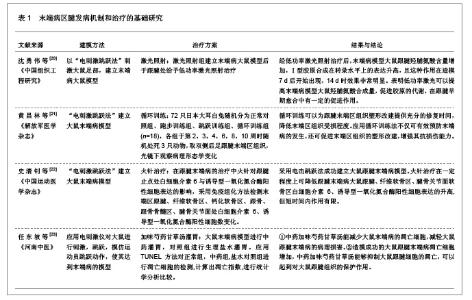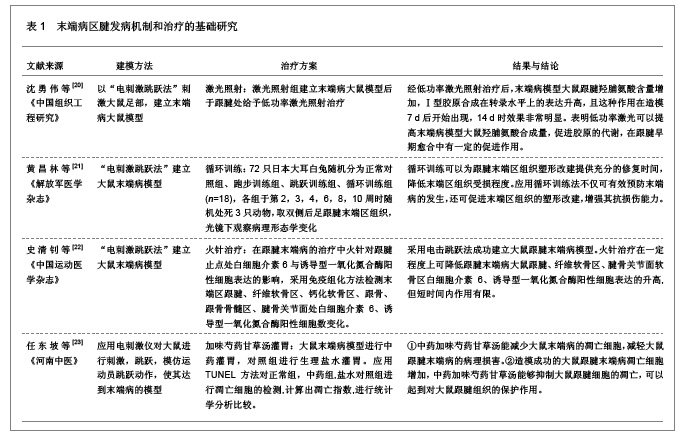Chinese Journal of Tissue Engineering Research ›› 2013, Vol. 17 ›› Issue (7): 1281-1288.doi: 10.3969/j.issn.2095-4344.2013.07.024
Previous Articles Next Articles
Nitric oxide effects on the bone and ligaments in enthesiopathy
Wang Wen-jun1, Wang Dan1, Bao Jie1, 2, Li Sheng-cun1, Cheng Long1, Wang Guo-xiang1
- 1 Soochow University, Suzhou 215021, Jiangsu Province, China
2 JM Biomedicine Engineering Instrument Cooperate Core Laboratory, Suzhou 215021, Jiangsu Province, China
-
Received:2012-08-22Revised:2012-12-08Online:2013-02-12Published:2013-02-12 -
Contact:Wang Guo-xiang, Doctor, Professor, Doctoral supervisor, Soochow University, Suzhou 215021, Jiangsu Province, China kwang63@163.com -
About author:Wang Wen-jun★, Master, Lecturer, Soochow University, Suzhou 215021, Jiangsu Province, China wangwj0729@sina.com
CLC Number:
Cite this article
Wang Wen-jun, Wang Dan1, Bao Jie, Li Sheng-cun, Cheng Long, Wang Guo-xiang. Nitric oxide effects on the bone and ligaments in enthesiopathy[J]. Chinese Journal of Tissue Engineering Research, 2013, 17(7): 1281-1288.
share this article

1 资料和方法 1.1 资料来源 2012年1至8月,由第一作者分别对CNKI、High wire、进行文献检索,检索数据时限为2005至2012年相关文献,以“一氧化氮、末端病”为中文检索词、“NO, enthesiopathy”为英文检索词的文章。 1.2 入选标准 纳入标准:①文章所述内容需与一氧化氮对末端病作用方面的研究密切相关。②选择近期发表或在权威杂志上发表。 排除标准:①与课题内容无关的文章。②重复性研究。 1.3 文献质量评估 共检索到135篇文献,按入选标准筛选,并排除非一氧化氮与末端病类研究,非一氧化氮影响因素类研究和重复性研究,最终共纳入43篇文章。 1.4 数据的提取 文章所有文献由作者独立搜索、筛选和提取,并通过讨论解决分歧。主要侧重一氧化氮与末端病相关性的研究。"


2 文献证据综合提炼 2.1 末端病的基本概况 末端病(Enthesiopathy)最初是以“附着区炎”形式出现,它是由La Cava1952年在描述颈椎韧带附着点的变性疾患时作为一个独立疾病首先提出的[1]。1959年他正式倡用“末端病”的名称。最近,许多研究学者提出用末端病一词来描述由于过度使用而导致腱以及腱周围疼痛的疾病[2]。至今,末端病的名称已被各国学者所接受,并且采用各种方法对末端区正常解剖结构及末端病的病理变化进行研究,对末端病的认识逐步深化[3-4]。末端病是指附着在骨上的部分肌腱、韧带、关节囊,由于慢性反复牵拉导致劳损而出现一系列病理变化的慢性疾病。末端病在运动员人群中发病率比较高,例如跟痛症、网球肘、跳跃膝、肩袖损伤等均属于末端病的范畴,一旦出现末端病就会严重的影响运动员的训练和成绩的提高,甚至缩短运动员的运动年限。因此,多年来一直是运动医学领域的研究热点之一。 末端区可分为主要结构和附属结构两部分。Dolgo sabaroff在1929年就明确指出,腱在骨上的止点结构不是骨膜结构,而是由腱、纤维软骨区、钙化软骨区和骨四部分组成[5]。腱是由胶原纤维构成的,末端区腱和纤维软骨内的胶原纤维属Ⅰ型胶原纤维。由细胞分泌转化形成,细胞分支蔓延为翼状包绕胶原纤维,构成第一腱束,大多数第一腱束外包绕少量结缔组织和血管,即第二腱束。第一腱束和第二腱束共同构成全腱。因此,第二腱束之内无血管分布,其营养必须依靠弥散作用来提供。Sharpey氏纤维、纤维软骨细胞和基质组成纤维软骨区。辅助结构包括腱围、滑囊、滑膜、脂肪垫及止点下软骨或软骨垫结构等部分。 由于末端区解剖结构的复杂性以及病理变化的多样性,致使许多研究学者对于末端病机制的研究观点不一致。但是综述众多研究学者的观点,末端病发病的机制大致分为两个方面:一方面是末端区组织结构的应力代偿适应;另一方面是末端结构局部微损伤导致的多种活性因子对末端结构的破坏作用[6-7]。末端病是一个损伤性病变疾病,末端区结构的主要功能是传递力到效应骨上,它本身不具有主动收缩的能力,因此从分子角度来讲,末端病是由于外界力被动牵拉末端区而引起组织内部一些分子结构发生变化引起的病变[8]。从组织病理学角度来看,末端病包括胶原纤维退化和紊乱;细胞结构增多;微炎症。显微镜下观察肌腱厚度增加,失去了机械性能。一些末端病深层次的研究指出,即从分子生物学角度来讲,基质金属蛋白酶的产生,腱细胞凋亡,腱组织变形以及一些保护性因子的表达(例如:一氧化氮合酶和胰岛素样生长因子1)都会发生在末端病中[9-10]。 2.2 一氧化氮介导的信号通路 一氧化氮(nitric oxide)是由一氧化氮合成酶生成的自由基,是左旋精氨酸(L-arginine)和活性氧分子为底物在一氧化氮合酶催化下生成的[11]。一氧化氮性质比较活泼、极其不稳定、半衰期很短,可迅速与机体内广泛存在的氧自由基反应,生成硝酸盐和亚硝酸盐。一氧化氮存在3种异构体:内皮型一氧化氮合成酶;神经性一氧化氮合成酶有诱导型一氧化氮合酶[12]。机体内的一氧化氮 具有双重作用,一氧化氮像其他自由基一样,大剂量的一氧化氮是有毒性的。然而,在生理剂量范围之内,当一氧化氮呈低速率产生时起着正常生理条件下的调节性和抗炎症效应,是生物体内分子之间信息传递的重要信息使,同时也是免疫应答反应的重要部分[13]。具有维持机体正常的免疫防御的功能。但是当巨噬细胞被大量的激活时,会导致一氧化氮浓度超过正常的生理水平,就会引起身体组织结构的损伤。 一氧化氮诱导末端区病变,实际上是应力应激共刺激引发的一些列的恶性循环过程,最终对细胞和细胞外基质产生毒性作用。一氧化氮诱导末端细胞的凋亡的主要生理机制为:持续高浓度的一氧化氮通过活化caspases 蛋白酶家族,释放细胞色素 c进入胞浆、上调丝裂原活化蛋白激酶(mitogen-activated protein kinase, MAPK)及p53 表达,同时抑制抗凋亡基因(Bel-2)表达从而引起细胞凋亡的发生;由于机械应力的刺激引起末端区蛋白水解下降及软骨细胞受到损伤,引起滑膜上产生大量的巨噬细胞,巨噬细胞的大量生成激活了白细胞介素1、肿瘤坏死因子α等炎性因子,这些炎性因子上调机体内一氧化氮的浓度,诱导细胞生成基质金属蛋白酶1和基质金属蛋白酶13(MMP-13,又称胶原蛋白3)。基质金属蛋白酶在正常的细胞的很少表达,只在病理状态下才出现高表达,最终破坏组织机构[14]。同时,细胞外基质因炎性递质或者机械应力影响而刺激细胞产生信号应答,由一氧化氮-一氧化氮合酶-环磷酸鸟苷介导信号转导通路激活可溶性鸟苷酸环化酶(sGC),使细胞内环磷酸鸟苷含量增加,环磷酸鸟苷又作为细胞内第2信使,通过调控离子通道、调节磷酸二酯酶(PDE)的活性、激活环一磷鸟苷酸依赖的蛋白激酶(GPK)和与环腺苷酸依赖的蛋白激酶(PKA)的交互作用,信号传递至细胞内并激活NF-kB;NF-kB刺激细胞合成一氧化氮合成酶和环氧合酶2,一氧化氮合成酶诱导产生大量一氧化氮,环氧合酶2催化合成前列腺素E2合成,一氧化氮和O2-结合导致ONOO-形成-使得细胞外基质中胶原氧化硝酸化,继而刺激p38 MAPK 和ERK1/2 磷酸化,p38MAPK进一步激活促炎转录因子NF-kB诱导合成一氧化氮合成酶和环氧合酶2蛋白,导致一氧化氮和前列腺素E2形成,抑制软骨细胞的增殖。 2.3 一氧化氮与对末端区腱的作用 腱组织是哺乳动物骨骼肌肉系统中重要的内部结构,具有将肌肉力传递到骨的作用。胶原蛋白是腱组织的重要组成部分(大于70%干质量)。在过去20年的实验研究已经证实了一氧化氮是腱损伤后由一氧化氮合酶的3种异构体诱导生成的,同时也证实了末端病提高了一氧化氮合酶的活性。在正常未受伤的腱中一氧化氮合酶的活性很低,在受伤的大鼠和人的腱中,在成纤维细胞治愈过程中发现有一氧化氮合酶短暂性的生成。扈盛等[15-17]研究人员利用动物末端病实验成功的发现,内皮型一氧化氮合成酶在大鼠跟腱、纤维软骨、钙化软骨、跟骨、骨髓腔等部位均有明显的表达,而对照组中的内皮型一氧化氮合成酶主要在大鼠跟腱周围处大量表达。内皮型一氧化氮合成酶作为一氧化氮合酶异构体之一,与其他两个异构体不一样,在机体内内皮型一氧化氮合成酶的活化需要游离Ca2+的激活。末端病大鼠模型中的组织细胞受到机械应力刺激时,可引起组织细胞内游离 Ca2+浓度的增加,进而激活内皮型一氧化氮合成酶。活化的内皮型一氧化氮合成酶加速了一氧化氮的合成,体内一氧化氮的水平迅速上调,高水平的一氧化氮作为信号的传递使者,将组织细胞上受到机械应力信号转化为生物信号来调控细胞的增殖、分化和凋亡以使末端结构进行适应性的重塑。诱导型一氧化氮合酶在其动物实验中也有表达,末端病组大鼠的诱导型一氧化氮合酶在跟腱、纤维软骨、钙化软骨、跟骨、骨髓腔等中的表达要明显的高与正常组大鼠。提示诱导型一氧化氮合酶为一种可溶性酶,在正常生理状态下不表达,可被细胞因子白细胞介素1和2、肿瘤坏死因子α等细胞因子及创伤等均可诱导诱导型一氧化氮合酶mRNA表达[18]。通过自分泌、旁分泌的作用, 生成大量一氧化氮,抑制软骨基质的合成。当末端区的组织结构持续出现细胞凋亡或者其他的异物时,这些坏死细胞使大量的巨噬细胞活化促使其产生白细胞介素1,白细胞介素1 激活诱导型一氧化氮合酶进而激活细胞内一系列信号通路,诱导型一氧化氮合酶 mRNA 表达迅速上调引起了一氧化氮浓度的增加。因此诱导型一氧化氮合酶的大量表达使末端区的一氧化氮浓度迅速升高加剧了炎症反应,加速了末端区的损伤。Szomor 等[19]研究学者利用大鼠成功获得冈上肌腱炎的模型,利用其模型研究一氧化氮对冈上肌腱炎的作用,经RT-PCR测试结果显示由于过度训练导致冈上肌腱损伤,一氧化氮合成酶的三种构体在冈上肌腱中的表达均有增加。诱导型一氧化氮合酶和内皮型一氧化氮合成酶 mRNA的表达增加了4倍,神经性一氧化氮合成酶 mRNA的表达与与对照组相比不是很明显。提示这个文章首次研究了一氧化氮合成酶三种构体在由于过度训练而导致腱袖损伤中表达均上调。证明了腱组织受到外界应力刺激时,一氧化氮的浓度增加是其重要应答反应之一。 末端病区腱发病机制和治疗的基础研究,见表1。 2.4 一氧化氮对末端区软骨的作用 高浓度一氧化氮不仅能加剧炎症反应,还可加重末端病的其他病症。一方面是诱导软骨细胞凋亡,在肢体缺血再灌注损伤后兔膝关节的试验中发现关节软骨细胞大量合成诱导型一氧化氮合酶。提示诱导型一氧化氮合酶参与了肢体再灌注后软骨损伤的过程,是诱导软骨细胞凋亡的主要因素之一。一氧化氮是实验性骨关节炎软骨细胞凋亡的重要介质,是软骨损伤的重要诱导因素。一氧化氮具有多种生物学效应:抑制软骨细胞增殖,抑制软骨细胞合成软骨基质,促进软骨细胞糖酵解。低浓度的一氧化氮加速软骨细的胞凋亡,而高浓度的一氧化氮则会导致软骨细胞死亡[24-25]。大量的研究表明异常增高诱导型一氧化氮合酶可直接或间接诱导软骨细胞的凋亡,导致末端区的组织结构中软骨细胞大量凋亡,从而使末端结构承受外界机械应力的能力及适应性的重塑能力大幅度降低,使末端病变陷入一个恶性循环之中。对大鼠跟腱末端病细胞凋亡的检测也证明了上述机制,其结果发现了造模组大鼠的细胞凋亡指数要比正常组大鼠高很多,尤其是在腱周围组织、腱骨联合处、跟腱、纤维软骨区及跟骨部分细胞凋亡指数最高。提示一氧化氮是软骨细胞凋亡的重要介质,是软骨损伤的重要因素且细胞凋亡指数随 一氧化氮 量变化而变化。另一方面抑制末端结构胶原的合成。末端区结构中正常的腱和纤维软骨内含有大量的Ⅰ型胶原纤维,Ⅰ型胶原纤维除了构成基本结构外,还具有一定的弹性,这种特殊的结构使末端区拥有了抗外界牵拉的能力[8, 26]。由于胶原纤维不具有主动收缩能力,受到长时间的被动牵拉会出现慢性的微损伤,激活了末端结构中白细胞介素1,白细胞介素1刺激产生的内源性一氧化氮可通过介导白细胞介素1减少末端结构中胶原纤维的合成,最终使末端结构失去了原有的弹性和抗牵张的能力,末端结构自我修复能力也进一步下降。在动物实验中给大鼠使用一氧化氮合酶抑制剂后发现一氧化氮合成减少,部分胶原纤维得到恢复,提示一氧化氮可抑制胶原的合成。"


2.5 一氧化氮对末端区骨的作用 一氧化氮参与了骨组织细胞的转换过程。机械应力是骨重塑的重要影响因素,同时它也可以刺激一氧化氮产生,最终使骨满足功能性需要。反复持续的机械应力作用在破骨细胞的前体细胞,上调了内皮型一氧化氮合成酶的表达,调高了一氧化氮的浓度,进而减低了破骨细胞的活性[27]。提示一氧化氮在破骨细胞活性中有着关键的作用,随着一氧化氮水平的下降,会提高破骨细胞的合成并伴随着骨吸收。高浓度的一氧化氮抑制了促进骨吸收的细胞活素类物质,而低浓度的一氧化氮则促使骨吸收的作用。成骨细胞通过一氧化氮-一氧化氮合酶-环磷酸鸟苷介导信号转导通路来减低外界的应力。成骨细胞内皮型一氧化氮合成酶不断诱导生成一氧化氮,促进成骨细胞的分化和增殖,在剔除内皮型一氧化氮合成酶的大鼠实验中发现,骨形成减少,缩小了骨容量。人和大鼠骨损伤时,一氧化氮合酶的3种异构体的活性会随之增加,表明了一氧化氮参与了骨的修复过程中。最近的临床研究指出以可控性和目标性的方式给予一氧化氮可以作为一种治疗骨损伤的最新、有效的方法[28]。从机械应力的角度讲,成骨细胞的分依靠于环磷酸鸟苷。环磷酸鸟苷是由一氧化氮激活可溶性的鸟甘酸环化酶形成的,在一氧化氮的生物学效应中起着重要的作用。在骨形成和骨修复的环境下,环磷酸鸟苷提高了碱性磷酸酶和骨钙的聚集,这就表明了成骨细胞分化和矿物质化。 一氧化氮与末端病的发病密切相关已经得到研究学者的公认,但是另有实验表明一氧化氮也参与了末端病的组织保护和修复。在末端病动物模型中,抑制一氧化氮合酶减低了腱的治愈效果,但是额外的增加一氧化氮会提高腱的治愈能力。在人体细胞体外的培养试验中,通过化学的手段额外增加一氧化氮提高了胶原蛋白的合成。一氧化氮通过促进胶原蛋白沉积和加固胶原蛋白对腱组织进行修复。一些研究已经表明了减少一氧化氮的生成减少了抑制了腱组织的修复和胶原蛋白的合成。对跟腱炎患者手术之后发现L-精氨酸和L-胍氨酸之间的转化有明显的增加(接近5倍),说明在跟腱治愈过程中一氧化氮合酶活性增加。在第七天增加到最高峰,14 d后恢复到正常水平。半定量聚合酶链反应和蛋白质印迹法用来检测一氧化氮合酶异构体在腱治愈过程中的表达量,手术4 d后,3异构体均有稳定的增加,诱导型一氧化氮合酶在第4天和第7天达到最高峰(增加了23倍),内皮型一氧化氮合成酶在第7天达到了最高峰(增加了24倍),提示内皮型一氧化氮合成酶的表达增加可能是促进腱及周围血管的增生,是促进组织修复的机制之一。神经性一氧化氮合成酶在第21天达到了最高峰(增加了7倍)[29]。在急性腱袖损伤中,采用反转录酶聚合酶链反应发现一氧化氮合酶的3种异构体均有表达,但是与跟腱炎模型中一氧化氮合酶的表达稍微有一点差异,神经性一氧化氮合成酶在第4天达到峰值,内皮型一氧化氮合成酶和诱导型一氧化氮合酶在第7天达到峰值[30-31]。在人体试验已经证实了一氧化氮能够影响一系列基因的表达。增加了组织之间(例如腱组织)细胞外基质基因的转录和翻译,包括胶原蛋白Ⅰ,胶原蛋白Ⅲ,胶原蛋白Ⅳ,双糖联蛋白多糖,核心蛋白聚糖,基板糖蛋白和基质金属蛋白酶10。而且,在肌腱固定术(腱修复的重要过程)一氧化氮水平的变化对细胞间的黏连有重要的作用[18, 32]。George在对患有网球肘、跟腱炎和腱袖损伤患者研究中也证实了,通过表皮注射给予一氧化氮,提高了这些患者的细胞外基质的合成,使受伤腱具有更好的材料和机械性能,愈合后腱的刚度要强于未使用额外一氧化氮的腱的刚度。Brett的人体试验中,将受试者分为随机组,控制组和临床组来研究一氧化氮是否能够提高跟腱的恢复,通过使用三硝酸甘油(GTN)经皮下来获取一氧化氮到达末端病疼痛的区域[33]。6个月之后,其他两组治疗效果明显好于控制组,除了减少疼痛,患者还感觉到末端区的功能得到了提高。治疗组81%的患者没有临床症状,控制组只有60%的人没有临床症状。同时,Paoloni在对跟腱炎进行长达5年的追踪研究中也得到了一致的研究结果[34],即通过GTN的方式给予一氧化氮,五年后治疗组88%的患者完全没有临床症状,而控制组的只有67%。 2.6 末端病的治疗机制及一氧化氮的影响 近年来,在末端病研究方面虽然已取得了一些突出成就,对末端区的解剖结构及病理变化的研究比较透彻,大部分学者已达成共识。但对末端病的病因、发病机制还了解较少,临床治疗也多为非手术疗法,疗效大多不肯定,并缺乏系统的机制研究;手术治疗虽见效快,但都不同程度地存在负面影响[35-37]。目前尚需运用组织学、细胞学、酶化学和生物力学等多学科相结合的方法,进一步完善末端病的病因病理及发病机制等基础研究和加强临床治疗的作用机制研究,从而研制出疗效肯定的损伤预防和临床治疗方法[38-39]。 末端病的病区会发生局部缺血的情况,血管增生等代偿性反应,潮线涨潮、腱纤维呈波浪扭曲等现象。运动后机体产生的氧自由基,是各器官损伤的主要机制之一。在末端病区跟腱部会有大量一氧化氮合酶表达,而一氧化氮合酶在局部产生大量一氧化氮有较强的细胞毒性,提示一氧化氮参与了末端病损伤的过程[40]。 一氧化氮参与末端病损伤过程的分析: 已发表文献:内皮型一氧化氮合酶在大鼠末端病中表达的研究 文献来源:2004年扈盛等[41]《全国软组织疼痛微创技术专题研讨会论文汇编》 主要观察指标:探讨内皮型一氧化氮合酶参与末端病过程中机体的保护性代偿反应方式。 结果与结论:内皮型一氧化氮合酶在末端病的过程中,表达明显增加,合成一氧化氮增多,参与了末端病发生过程中局部微循环的新建和代偿性结构变化,并抑制细胞凋亡,对机体有很好的保护作用。 已发表文献: 内皮型一氧化氮合酶在大鼠末端病中的表达 文献来源:2005年扈盛等[15]《中国运动医学杂志》 主要观察指标:末端病大鼠跟腱末端区内皮型一氧化氮合酶的分布,探讨内皮型一氧化氮合酶与血管新生的关系及其在末端病中对机体的保护作用。 结果与结论:大鼠末端病区跟腱、纤维软骨、钙化软骨、跟骨、骨髓腔、腱骨关节面及腱围等部位内皮型一氧化氮合酶表达明显,腱围及骨髓腔处表达最多。提示内皮型一氧化氮合酶可能参与了末端病组织血管的新生,组织结构功能适应及抑制细胞凋亡等代偿性反应。 已发表文献:诱导型一氧化氮合酶在末端病大鼠跟腱末端区表达及分布的规律 文献来源:2005年王和平等[42]《中国临床康复》 主要观察指标:探讨诱导型一氧化氮合酶在末端病大鼠跟腱末端区组织的损伤及适应性改变中的作用。 结果与结论:诱导型一氧化氮合酶在末端病大鼠大鼠跟腱末端区各部位均有明显表达,大部分区域和对照组大鼠存在较明显的差异。诱导型一氧化氮合酶在末端病大鼠跟腱末端区的发病中可能起着双重作用,它除了介导组织的损伤过程外还对末端区组织在结构和功能上的适应性改变起着调控作用。 已发表文献:跟腱末端病的发病和保护修复机制 文献来源:2010年黎明等[43]《中国中医骨伤科杂志》。 主要观察指标:为探讨末端病的发病和修复机制,为寻找有效的防治方法提供实验依据。 结果与结论:腱纤维局部诱导型一氧化氮合酶导致的细胞死亡,局部细微裂痕和周围组织细胞变性,可能是造成其损害的主要原因。HSP和内皮型一氧化氮合酶表达促进局部的毛细血管增生,都是促进细胞保护的机制。"

| [1] Xu Y, Murrell GA. The basic science of tendinopathy.Clin Orthop Relat Res. 2008;466(7):1528-1538. [2] Archambault JM, Jelinsky SA, Lake SP, et al. Rat supraspinatus tendon expresses cartilage markers with overuse. J Orthop Res. 2007;25(5):617-624. [3] Battery L,Maffulli N.Inflammation in overuse tendon injuries.Sports Med Arthrosc.2011;19(3):213-217.[4] Bass E. Tendinopathy: why the difference between tendinitis and tendinosis matters. Int J Ther Massage Bodywork. 2012; 5(1):14-17. [5] 方小芳,史清钊,周军.末端病发病机制的国内外研究现状[J].中国康复医学杂志,2009,24 (11):1055-1058.[6] Dirks RC, Warden SJ. Models for the study of tendinopathy. J Musculoskelet Neuronal Interact. 2011;11(2):141-149. [7] J P, U F, K Q, et al. Local biochemical and morphological differences in human Achilles tendinopathy: a case control study. BMC Musculoskelet Disord. 2012 Apr 5;13:53. [8] Maganaris CN,Narici MV,Maffulli N.Biomechanics of the Achilles tendon.Disabil Rehabil. 2008;30(20-22):1542-1547.[9] Thomas MV, Puleo DA. Infection, inflammation, and bone regeneration: a paradoxical relationship. J Dent Res. 2011; 90(9):1052-1061. [10] Rangaswami H, Marathe N, Zhuang S, et al. Type II cGMP-dependent protein kinase mediates osteoblast mechanotransduction. J Biol Chem. 2009;284(22):14796- 14808. [11] 林松娟,刘美娟,王蓬伟,等. L-精氨酸干预治疗对 COPD 大鼠肺动脉压的影响[J].现代预防医学.2011;38(21):4479-4480. [12] Bokhari AR, Murrell GA. The role of nitric oxide in tendon healing. J Shoulder Elbow Surg. 2012;21(2):238-244.[13] Murrell GA. Using nitric oxide to treat tendinopathy. Br J Sports Med. 2007;41(4):227-231.[14] Yang L, Guo A, Gu JC.c-Jun N-terminal kinase and nuclear fact or κB mediate nitric oxide-induced expression of matrix met alloproteinase-13. International Orthopedics (SICOT). 2011;35:1261–1266. [15] 扈盛,滕宇,胡亚哲,等.内皮型一氧化氮合酶在大鼠末端病中的表达[J].中国运动医学杂志,2005,24(6):689-692.[16] Benjamin M, Kaiser E, Milz S. Structure-function relationships in tendons: a review. J Anat. 2008;212(3):211-228.[17] 杨小英,梁蓓蓓,黄志平等.不同运动负荷大鼠主要器官各型 NOS 表达水平的研究[J]. 现代预防医学,2011,38(13): 2550-2553. [18] Jelinsky SA, Rodeo SA, Li J, et al. Regulation of gene expression in human tendinopathy. BMC Musculoskelet Disord. 2011;12:86.[19] Szomor ZL,Appleyard RC,Murrell GA.Overexpression of nitric oxide synthases in tendon overuse.Orthop Res.2006;24(1): 80-86. [20] 沈勇伟,史晓伟.低功率激光修复末端病大鼠跟腱胶原[J]. 中国组织工程研究,2012,16(28):5165-5169.[21] 黄昌林,高旺,黄涛,等. 循环训练模式对兔跟腱末端区组织形态学的影响[J]. 解放军医学杂志,2012,37(5):515-518.[22] 史清钊,方小芳,周军,等. 火针治疗对跟腱末端病大鼠跟腱止点组织IL-6与iNOS表达的影响[J]. 中国运动医学杂志,2011,30(7): 650-655.[23] 任东坡,唐欣荣,吕发明. 加味芍药甘草汤对大鼠跟腱末端病影响的实验研究[J]. 河南中医,2009,29(5):455-457.[24] Abramson SB. Nitric oxide in inflammation and pain associated with osteoarthritis. Arthritis Res Ther. 2008;10 Suppl 2:S2.[25] 田学忠,刘越, 陈华.白细胞介素1和诱导型一氧化氮合酶在兔肢体缺血再灌注后关节软骨中的表达[J].中国组织工程研究与临床康复.2007;11(45):9021-9025.[26] Forterre S, Zurbriggen A, Spreng D. Nitric oxide induces cell death in canine cruciate ligament cells by activation of tyrosine kinase and reactive oxygen species. [27] Nichols SP, Storm WL, Koh A, et al. Local delivery of nitric oxide: targeted delivery of therapeutics to bone and connective tissues. Adv Drug Deliv Rev. 2012;64(12):1177- 1188.[28] Khosla S. Is nitroglycerin a novel and inexpensive treatment for osteoporosis? JAMA. 2011;305(8):826-827.[29] Murrell GA, Tang G, Appleyard RC, et al. Addition of nitric oxide through nitric oxide-paracetamol enhances healing rat achilles tendon. Clin Orthop Relat Res. 2008;466(7):1618- 1624.[30] Ryu B, Qian ZJ, Kim SK. SHP-1, a novel peptide isolated from seahorse inhibits collagen release through the suppression of collagenases 1 and 3, nitric oxide products regulated by NF-kappaB/p38 kinase. Peptides. 2010;31(1):79-87.[31] Saito Y, Sawa T, Yoshitake J, et al. Nitric oxide promotes recycling of 8-nitro-cGMP, a cytoprotective mediator, into intact cGMP in cells. Mol Biosyst. 2012;8(11):2909-2915.[32] Molloy TJ, de Bock CE, Wang Y, et al. Gene expression changes in SNAP-stimulated and iNOS-transfected tenocytes--expression of extracellular matrix genes and its implications for tendon-healing. J Orthop Res. 2006;24(9): 1869-1882.[33] McCarrel TM, Minas T, Fortier LA. Optimization of leukocyte concentration in platelet-rich plasma for the treatment of tendinopathy. J Bone Joint Surg Am. 2012;94(19):e1431- 1438.[34] McCallum SD, Paoloni JA, Murrell GA. Five-year prospective comparison study of topical glyceryl trinitrate treatment of chronic lateral epicondylosis at the elbow. Br J Sports Med. 2011;45(5):416-420.[35] 赵晓芳, 王刚, 孙先润,等.体外震波仪治疗肌腱末端病的临床研究[J].中国矫形外科杂志,2012,20(19):1806-1808.[36] 雷鸣鸣,张璐. 体外冲击波治疗国家队运动员髌腱末端病的疗效分析[J]. 华西医学,2012,27(01):37-39.[37] 魏军成, 纪益魁. 微型骨锚在治疗跟腱末端病的应用[J]. 浙江创伤外科,2010,15(03):326-327.[38] 王国祥, 严永军,岳春林. 髌腱末端病运动员膝关节等速向心和离心运动时股四头肌表面肌电的变化[J]. 中国组织工程研究与临床康复,2009,13(46):9105-9108.[39] 郭佳佳,史清钊,张玉芹.末端病基础研究和临床治疗的国内外研究现状[J]. 现代生物医学进展,2009,9(22):4397-4400.[40] 方小芳,史清钊,周军.末端病发病机制的国内外研究现状[J]. 中国康复医学杂志,2009,24(11):1055-1058. [41] 扈盛,滕宇,胡亚哲.内皮型一氧化氮合酶在大鼠末端病中表达的研究[G]. 全国软组织疼痛微创技术专题研讨会论文汇编,2004.[42] 王和平,滕宇,胡亚哲,等. 诱导型一氧化氮合酶在末端病大鼠跟腱末端区表达及分布的规律[J]. 中国临床康复,2005,9(24): 159-161.[43] 黎明,韩红,滕宇,等.跟腱末端病的发病和保护修复机制[J]. 中国中医骨伤科杂志,2010,4:10-12. |
| [1] | Xu Feng, Kang Hui, Wei Tanjun, Xi Jintao. Biomechanical analysis of different fixation methods of pedicle screws for thoracolumbar fracture [J]. Chinese Journal of Tissue Engineering Research, 2021, 25(9): 1313-1317. |
| [2] | Jiang Yong, Luo Yi, Ding Yongli, Zhou Yong, Min Li, Tang Fan, Zhang Wenli, Duan Hong, Tu Chongqi. Von Mises stress on the influence of pelvic stability by precise sacral resection and clinical validation [J]. Chinese Journal of Tissue Engineering Research, 2021, 25(9): 1318-1323. |
| [3] | Zhang Tongtong, Wang Zhonghua, Wen Jie, Song Yuxin, Liu Lin. Application of three-dimensional printing model in surgical resection and reconstruction of cervical tumor [J]. Chinese Journal of Tissue Engineering Research, 2021, 25(9): 1335-1339. |
| [4] | Zhang Yu, Tian Shaoqi, Zeng Guobo, Hu Chuan. Risk factors for myocardial infarction following primary total joint arthroplasty [J]. Chinese Journal of Tissue Engineering Research, 2021, 25(9): 1340-1345. |
| [5] | Wei Wei, Li Jian, Huang Linhai, Lan Mindong, Lu Xianwei, Huang Shaodong. Factors affecting fall fear in the first movement of elderly patients after total knee or hip arthroplasty [J]. Chinese Journal of Tissue Engineering Research, 2021, 25(9): 1351-1355. |
| [6] | Wang Jinjun, Deng Zengfa, Liu Kang, He Zhiyong, Yu Xinping, Liang Jianji, Li Chen, Guo Zhouyang. Hemostatic effect and safety of intravenous drip of tranexamic acid combined with topical application of cocktail containing tranexamic acid in total knee arthroplasty [J]. Chinese Journal of Tissue Engineering Research, 2021, 25(9): 1356-1361. |
| [7] | Xiao Guoqing, Liu Xuanze, Yan Yuhao, Zhong Xihong. Influencing factors of knee flexion limitation after total knee arthroplasty with posterior stabilized prostheses [J]. Chinese Journal of Tissue Engineering Research, 2021, 25(9): 1362-1367. |
| [8] | Huang Zexiao, Yang Mei, Lin Shiwei, He Heyu. Correlation between the level of serum n-3 polyunsaturated fatty acids and quadriceps weakness in the early stage after total knee arthroplasty [J]. Chinese Journal of Tissue Engineering Research, 2021, 25(9): 1375-1380. |
| [9] | Zhang Chong, Liu Zhiang, Yao Shuaihui, Gao Junsheng, Jiang Yan, Zhang Lu. Safety and effectiveness of topical application of tranexamic acid to reduce drainage of elderly femoral neck fractures after total hip arthroplasty [J]. Chinese Journal of Tissue Engineering Research, 2021, 25(9): 1381-1386. |
| [10] | Wang Haiying, Lü Bing, Li Hui, Wang Shunyi. Posterior lumbar interbody fusion for degenerative lumbar spondylolisthesis: prediction of functional prognosis of patients based on spinopelvic parameters [J]. Chinese Journal of Tissue Engineering Research, 2021, 25(9): 1393-1397. |
| [11] | Lü Zhen, Bai Jinzhu. A prospective study on the application of staged lumbar motion chain rehabilitation based on McKenzie’s technique after lumbar percutaneous transforaminal endoscopic discectomy [J]. Chinese Journal of Tissue Engineering Research, 2021, 25(9): 1398-1403. |
| [12] | Chen Xinmin, Li Wenbiao, Xiong Kaikai, Xiong Xiaoyan, Zheng Liqin, Li Musheng, Zheng Yongze, Lin Ziling. Type A3.3 femoral intertrochanteric fracture with augmented proximal femoral nail anti-rotation in the elderly: finite element analysis of the optimal amount of bone cement [J]. Chinese Journal of Tissue Engineering Research, 2021, 25(9): 1404-1409. |
| [13] | Du Xiupeng, Yang Zhaohui. Effect of degree of initial deformity of impacted femoral neck fractures under 65 years of age on femoral neck shortening [J]. Chinese Journal of Tissue Engineering Research, 2021, 25(9): 1410-1416. |
| [14] | Zhang Shangpu, Ju Xiaodong, Song Hengyi, Dong Zhi, Wang Chen, Sun Guodong. Arthroscopic suture bridge technique with suture anchor in the treatment of acromioclavicular dislocation [J]. Chinese Journal of Tissue Engineering Research, 2021, 25(9): 1417-1422. |
| [15] | Liang Yan, Zhao Yongfei, Xu Shuai, Zhu Zhenqi, Wang Kaifeng, Liu Haiying, Mao Keya. Imaging evaluation of short-segment fixation and fusion for degenerative lumbar scoliosis assisted by highly selective nerve root block [J]. Chinese Journal of Tissue Engineering Research, 2021, 25(9): 1423-1427. |
| Viewed | ||||||
|
Full text |
|
|||||
|
Abstract |
|
|||||